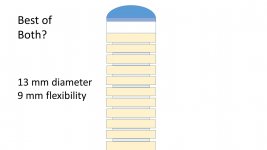I think Oscar's was even smaller than that, somewhere in the 8.5-9mm range...
Mine is 11.22...but is also LD beyond just it's thinness...I designed a LD shaft by reducing endmass but designing it in a way to not reduce that solid shaft feel. I liked the benefits of LD shafts, but didn't like the hollow feel that most on the market provided, So I spent the better part of a decade designing mine.
Jaden
Are you marketing them?
Be well
